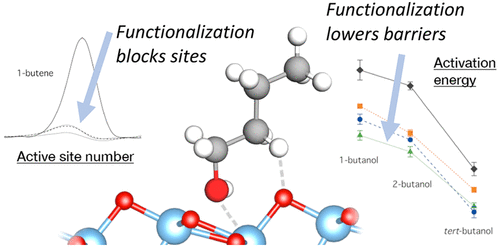当前位置:
X-MOL 学术
›
ACS Catal.
›
论文详情
Our official English website, www.x-mol.net, welcomes your
feedback! (Note: you will need to create a separate account there.)
Effects of Phosphonic Acid Monolayers on the Dehydration Mechanism of Aliphatic Alcohols on TiO2
ACS Catalysis ( IF 11.3 ) Pub Date : 2019-07-17 00:00:00 , DOI: 10.1021/acscatal.9b02082 Jordi Ballesteros-Soberanas 1 , Lucas D. Ellis 1 , J. Will Medlin 1
ACS Catalysis ( IF 11.3 ) Pub Date : 2019-07-17 00:00:00 , DOI: 10.1021/acscatal.9b02082 Jordi Ballesteros-Soberanas 1 , Lucas D. Ellis 1 , J. Will Medlin 1
Affiliation

|
The kinetics for surface-catalyzed alcohol dehydration reactions often depend on the structure of the alcohol. Studies of structure–activity relations across primary, secondary, and tertiary alcohols can provide fundamental information on the nature of active sites on the surface. Here, we investigated the dehydration of 1-butanol, 2-butanol, and tert-butanol over TiO2 anatase catalysts modified with various phosphonic acid (PA) self-assembled monolayers (SAMs). As a response to the presence of PAs, the three C4 alcohol isomers showed different dehydration rates, with 1-butanol dehydration being enhanced to the greatest extent by PA modification. Furthermore, the fluorinated, more polar 4-fluorobenzylphosphonic acid outperformed alkyl PAs across all alcohols. Steady-state kinetic measurements and temperature-programmed desorption studies indicated that PA SAMs significantly lowered the dehydration activation barrier; the extent of reduction in the barrier was sensitive to both the substitution of the alcohol and the charge distribution on the PA in a way that was consistent with stabilization of a carbenium-like transition state. Overall, the effect of PA modifiers on alcohol dehydration rates was found to be determined from a balance between transition state stabilization and active site blocking effects, with the potential to tune activity and selectivity based on the structure and coverage of the SAM.
中文翻译:

膦酸单层对脂肪醇在TiO 2上脱水机理的影响
表面催化的醇脱水反应的动力学通常取决于醇的结构。对伯,仲和叔醇的结构活性关系的研究可以提供有关表面活性部位性质的基本信息。在这里,我们研究了TiO 2上1-丁醇,2-丁醇和叔丁醇的脱水各种膦酸(PA)自组装单层(SAMs)改性的锐钛矿型催化剂。作为对PAs的响应,三种C4醇异构体表现出不同的脱水速率,其中PA改性最大程度地提高了1-丁醇的脱水率。此外,氟化的极性更强的4-氟苄基膦酸在所有醇类中的烷基PA的性能均优于。稳态动力学测量和程序升温脱附研究表明,PA SAMs显着降低了脱水活化屏障。势垒减少的程度对醇的取代和PA上的电荷分布均敏感,其方式与碳正离子状过渡态的稳定相一致。全面的,
更新日期:2019-07-17
中文翻译:

膦酸单层对脂肪醇在TiO 2上脱水机理的影响
表面催化的醇脱水反应的动力学通常取决于醇的结构。对伯,仲和叔醇的结构活性关系的研究可以提供有关表面活性部位性质的基本信息。在这里,我们研究了TiO 2上1-丁醇,2-丁醇和叔丁醇的脱水各种膦酸(PA)自组装单层(SAMs)改性的锐钛矿型催化剂。作为对PAs的响应,三种C4醇异构体表现出不同的脱水速率,其中PA改性最大程度地提高了1-丁醇的脱水率。此外,氟化的极性更强的4-氟苄基膦酸在所有醇类中的烷基PA的性能均优于。稳态动力学测量和程序升温脱附研究表明,PA SAMs显着降低了脱水活化屏障。势垒减少的程度对醇的取代和PA上的电荷分布均敏感,其方式与碳正离子状过渡态的稳定相一致。全面的,






























 京公网安备 11010802027423号
京公网安备 11010802027423号